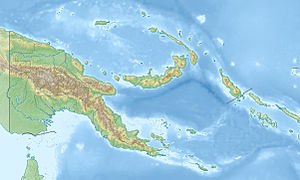Dyaul
| Dyaul Sandwich Island (former name) |
||
|---|---|---|
| NASA satellite image of the island | ||
| Waters | Bismarck lake | |
| Archipelago | Bismarck Archipelago | |
| Geographical location | 2 ° 56 ′ S , 150 ° 53 ′ E | |
|
|
||
| length | 30 km | |
| width | 8 kilometers | |
| surface | 100 km² | |
| Highest elevation | Mount Bendemann 226 m |
|
| Residents | 1000 10 inhabitants / km² |
|
| main place | Sumuna | |
| Dyaul is in the lower right corner of the map | ||
Dyaul (also Djaul or formerly Sandwich Island ) is an island off the coast of the island of New Ireland in the north of Papua New Guinea . It is part of the Bismarck Archipelago and administratively belongs to the Tikana Rural Local-Level Government Area of the Province of New Ireland .
geography
Dyaul is separated from the southwest coast of New Ireland by the 14 km wide Gazelle Canal. In the northern part of the island is the Andesite , 226 m high Mount Bendemann (Kulebetet), named after the imperial admiral Felix von Bendemann . The average height of the terrain is 60 m and is mainly formed from upscale coral limestone . In the west is the small island of Mait with the 230 m high Dietert Peak. It is separated from Dyaul by the narrow Mait Canal. The islands of Leamon and Kalawurima are off the south coast.
Residents
The inhabitants live mainly in seven villages. The largest places are Sumuna with the mission station on the north coast, and Lapai, Piliwa and Karia in the east. Not counting Tok Pisin , two languages are spoken on Dyaul : Tigak and Tiang. Tigak is spoken in two villages in the western part and Tiang in the rest of the island. The Dyaul or Bismarck monarch is endemic to Dyaul.
history
The island has probably been in existence since around 1500 BC. Inhabited by Melanesians . In 1767 the island was discovered by the British navigator and explorer Philipp Carteret . The area came under German administration in 1885 and belonged to German New Guinea since 1899 . During the First World War , Australian troops captured the island. After the war it was administered as a mandate of the League of Nations of Australia.
Dyaul was occupied by Japan from 1942 to 1944, but returned to Australian administration in 1949 until Papua New Guinea gained independence in 1975.
literature
Keyword Djaul. In: Heinrich Schnee (Ed.): German Colonial Lexicon. Quelle & Meyer, Leipzig 1920, Volume I, p. 469 ( online ).


